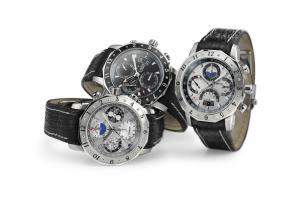CIMIER – from 1924 to today
In 1925, the first ads from a company Lapanouse SA appeared, featuring Swiss watches under the brand name CIMIER.
The company had been founded the year before by the watchmaker R. Lapanouse in Hölstein, a small and structurally weak town in the canton Baselland. The comfortably manageable family enterprise had been producing the so-called “Roskopf” watches since its relocation to the neighbouring Bubendorf. This type of watch originates from the watchmaker Georg Friedrich Roskopf, who lived 1813 – 1889. He developed very robust and exceptionally reasonably priced clockworks, featuring vertically standing steel pins instead of the usual stone palettes for the time scaling. Further characteristics were the economic pillar construction, a light balance wheel, the relatively thick balance shaft as protection against breakage, and comparatively few jewels.
A whole new range of customers was addressed with the production of these affordable watches, and Lapanouse SA rushed from success to success. There was, however, a sour note in the history of the rapidly upcoming company: The Achilles’ heel of its extraordinarily purposeful strategy came to light in 1934, when production was frozen at the respective status quo by Swiss Federal Law. Historical documents prove that this measure was taken to protect the crisis-ridden watch industry. Accordingly, Lapanouse was restricted to producing exclusively Roskopf clockworks and watches containing these.
Creativity was not impaired, however! The ambitious enterprise now focused on an even broader and more attractive collection for ordinary people, consisting mainly of wristwatches.
In 1951, as the branch was gradually recovering from the aftermath of the Second World War, Lapanouse SA managed to stand out with exceptionally good results. A new range of wrist watches was presented, with gold plated or chromed casings, still featuring the successful pin lever movement from the company’s own production. The CIMIER brand, now also reflected in the new company name LAPANOUSE-CIMIER, set out to capture the world. In English, CIMIER means “Crest” (as in the decoration on a helmet), and this melodious name was to be understood as a symbol for the combination of elegance and stability.
The age of the beginning economic boom demanded more striking and distinctive wrist watches, and CIMIER launched pieces with luminescent numerals, center second, as well as a novel chronograph. The company’s pioneer role in this field was to pay off: The striking timepieces were sold very successfully worldwide, and even the company’s stationery proudly announced: “Production of 5000 watches daily”. An incredible 1,5 million watches were produced yearly by the 500 employees in Bubendorf.
The key markets at that time were the USA and Europe, as well as South America, Australia, and South Africa.
In 1966, the obstructive 1934 Federal Law paragraph was finally abolished, but Lapanouse saw no reason to leave the reliable pin lever terrain. The range was to be extended, instead of cut back or even given up. The result was a pin lever chronograph with seven stones and two pushers for controlling diverse functions, as well as several additional dials. The simultaneous arrangement of tachy and telemeter scale completed its impressive appearance.
In the seventies, pulsating quartz crystals were introduced to the watch industry. Lapanouse SA applied itself to this new technology and once again adopted a pioneer role in developing its own quartz movement.
In a risky transaction, a large part of the production machines was sold to a competitor at the beginning of the 80s, who was henceforth to be a supplier of the company. This outsourcing measure, however, did not result in the expected reduction of production costs. On the contrary; due to the now costly purchase
of movements, Lapanouse-Cimier clearly suffered a competitive disadvantage when it came to competitors from abroad, and particularly when it came to the important new domestic player.
Disaccord within the owner family concerning the future strategy and the choice of a successor to head the enterprise finally lead to the provisional production shut-down in one of the largest Swiss watch manufactures in 1985.
CIMIER today
Since 2003, the long-standing tradition of the brand is being carried toward the future by a young team with experience in different Swiss watch manufactures. The most prominent characteristics of a CIMIER are still high-class workmanship, the remarkable design and an affordable price. The CIMIER atelier in Zug (Central Switzerland) not only designs and develops these exclusive timepieces, but also manufactures them in finest handcraft.


